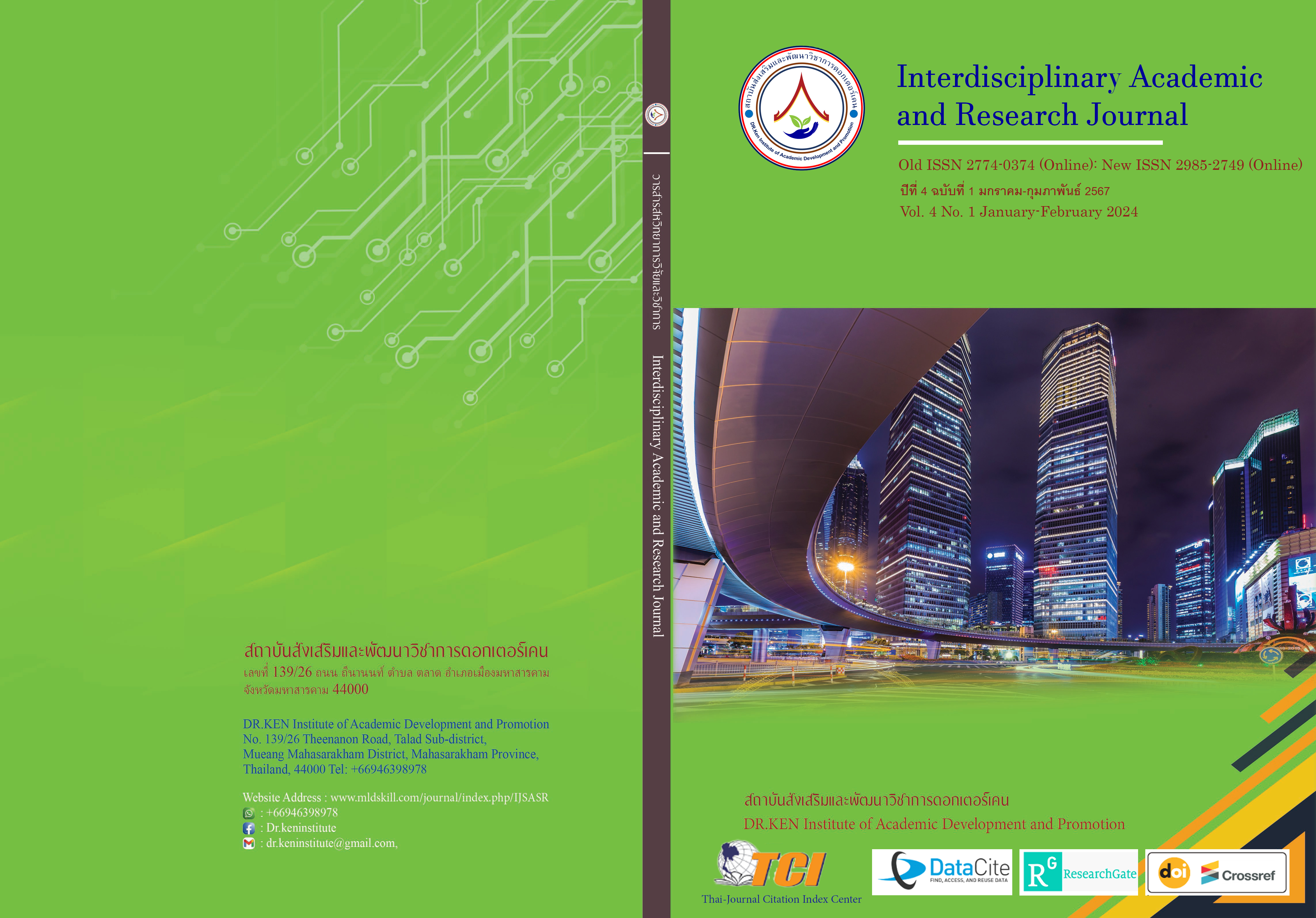The Development of Science Learning Activities according to the Buddhist Method Together with Concept Maps of Student Achievement Grade 4
DOI:
https://doi.org/10.60027/iarj.2024.270920Keywords:
Organizing Learning Activities; , Buddhist Method Together with Concept Maps; , Academic AchievementAbstract
Background and Aims: The development of science learning activities is important and necessary in today's society with rapid advancements in science and technology. The development of activities is the basis that encourages students to develop other higher thinking skills and be able to make decisions. Solve the problem correctly, the researcher is therefore interested in doing this research with the objective (1) Study information on the development of science learning activities. (2) Design science learning activities according to the 80/80 criteria and the effectiveness index. More than 50 percent. (3) Compare the academic achievement of students studying. And (4) Study the satisfaction of students studying.
Methodology: The sample was 26 students, Mathayom 4 at Srisuk Phitthayakhom School, Maha Sarakham Provincial Administrative Organization in the 2nd semester of, the academic year 2021. The research tools include 1) a learning management plan, 2) an academic achievement measurement test, and 3) a satisfaction questionnaire. Statistics used in data analysis include percentage, mean, standard deviation (SD), and t-test (Dependent Samples).
Results: (1) Developmental results of science learning activities according to Buddhist methods together with concept maps on learning found there were basic concepts of learning activities in a systematic, step-by-step for 6 steps: 1) arouse interest, 2) reflection, 3) practice, 4) information discussion, 5) conclusion, and 6) knowledge application. Opinions of 5 experts on the quality of the activities were at the highest level in all respects, the average is between 4.70- 5.00 indicating that it is suitable for use in teaching and learning activities. (2) Design for the development of science learning activities found that 2.1) the efficiency of science learning activities according to Buddhist methods, 2.2) the effectiveness index of the learning process using the conceptual mapping approach to the conceptual mapping on the learning achievement was 85.02/81.22 according to the 80/80 criterion, and 2.2) the effectiveness index of the learning process using the organization, science learning activities according to the Buddhist method together with the concept map on learning achievement was .6331 higher than the specified criteria. (3) The students' learning achievement by using science learning activities after studying is higher than before with statistically significant at .01 level. (4) the students had satisfaction with their learning by using science learning activities as a whole and each item was at a high level.
Conclusion: The study found that the science learning activities developed through the Buddhist method and concept maps had a structured 6-step process, which was unanimously praised by experts for their suitability for teaching. The effectiveness of the design is demonstrated by its effectiveness in science learning. Crossing the threshold for success and significantly improving student learning outcomes High student satisfaction also underscores the success of these activities in promoting better understanding and participation in science education.
References
พระทนง ชยาภรโณ (วงคสายะ) (2554). การเรียนการสอนตามแนววิถีพุทธชั้นมัธยมศึกษาปีที่ 1 โรงเรียนน้ำดิบวิทยาคม อำเภอป่าซาง จังหวัดลำพูน. บัณฑิตวิทยาลัย มหาวิทยาลัยมหาจุฬาลงกรณราชวิทยาลัย.
มนต์ชัย พงศกรนฤวงษ์. (2552). การพัฒนารูปแบบการเรียนการสอนตามทฤษฎีการสร้างความรู้ เพื่อส่งเสริมความสามารถในการสร้างความรู้ของนักเรียนช่างอุตสาหกรรม. วิทยานิพนธ์ปรัชญาดุษฏีบัณฑิต สาขาวิชาหลักสูตรและการสอนมหาวิทยาลัยศิลปากร.
เยาวนาตร อินทร์สาเภา. (2552). ผลของการจัดประสบการณ์การเรียนรู้ตามแนวปรัชญาเศรษฐกิจพอเพียงที่มีต่อพฤติกรรมการอนุรักษ์สิ่งแวดล้อมของเด็กปฐมวัย โรงเรียนสาธิตพิบูลบำเพ็ญมหาวิทยาลัยบูรพา จังหวัดชลบุรี. วิทยานิพนธ์ปรัชญาดุษฏีบัณฑิต (สาขาหลักสูตรและการสอน): มหาวิทยาลัยบูรพา.
โรงเรียนศรีสุขพิทยาคม. (2563). ข้อมูลโรงเรียน. มหาสารคาม : โรงเรียนศรีสุขพิทยาคม.
วรรณภา โคตรพันธ์. (2552). การศึกษาผลสัมฤทธิ์ทางการเรียนและความสามารถในการคิดวิเคราะห์ของนักเรียนชั้นมัธยมศึกษา ปีที่2 ที่ได้รับการจัดการเรียนรู้โดยใช้ชุดกิจกรรม การเขียนผังมโนมติ. วิทยานิพนธ์ปริญญาการศึกษามหาบัณฑิต สาขาวิชาการมัธยมศึกษา. กรุงเทพฯ : มหาวิทยาลัยศรีนครินทรวิโรฒ,
สมพงษ์ ฤทธิแผลง. (2553). ความคิดเห็นของนักเรียนต่อการจัดสภาพแวดล้อมภายในโรงเรียนของโรงเรียนสังกัดอำเภอพญาเม็งราย สำนักงานเขตพื้นที่การศึกษาเชียงราย เขต 4. การศึกษาอิสระ ครุศาสตรมหาบัณฑิต, มหาวิทยาลัยราชภัฏเชียงราย
สุวิทย์ มูลคำ และอรทัย มูลคำ. (2546). 20 วิธีจัดการเรียนรู้. กรุงเทพฯ : ภาพพิมพ์.
อุทัย วรเมธีศรีสกุล และคณะ. (2561). พุทธวิธีการเรียนการสอน. วารสารบัณฑิตศึกษามหาจุฬาขอนแก่น, 5(1), 71-81.
Novak, J. D., & Cañas, A. J. (2008). The theory underlying concept maps and how to construct and use them. Technical Report IHMC Cmap Tools 2006-01 Rev 01-2008, Florida Institute for Human and Machine Cognition.
Zenner, C., Herrnleben-Kurz, S., & Walach, H. (2014). Mindfulness-based interventions in schools—A systematic review and meta-analysis. Frontiers in Psychology, 5, 603.
Downloads
Published
How to Cite
Issue
Section
License
Copyright (c) 2024 Ratchataporn Meechai, Samarn Ekkapim

This work is licensed under a Creative Commons Attribution-NonCommercial-NoDerivatives 4.0 International License.
Copyright on any article in the Interdisciplinary Academic and Research Journal is retained by the author(s) under the under the Creative Commons Attribution-NonCommercial-NoDerivatives 4.0 International License. Permission to use text, content, images, etc. of publication. Any user to read, download, copy, distribute, print, search, or link to the full texts of articles, crawl them for indexing, pass them as data to software, or use them for any other lawful purpose. But do not use it for commercial use or with the intent to benefit any business.
















.png)


